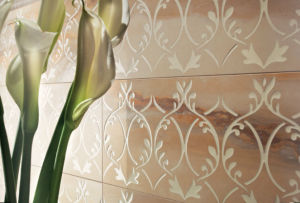Although some people consider leaving it to the professionals, most bathrooms can be tiled in a weekend, even if you have had no previous tiling experience.
Before you begin, you will need:
· Tile Cutter
· Tile Saw
· Grout Spreader
· Spirit Level
· Tile Nibblers
· Adhesive Spreader
· Tile-Cutting Jig
· Gauge Stick
Preparation
Make sure the walls are clean and dry, with the surface as flat as possible. The gauge stick will help you plot the position of the tiles on the wall. Find a piece of softwood and lay several tiles next to it (adding spacers if the tiles are square edged or butting together those with lugs) and mark off the position of each tile along the stick.
Setting Out The Tiles
The size and shape of your bathroom ultimately decides on how you set out the walls. Mark the bottom of the lowest row of tiles and temporarily nail a thin guide batten to the wall, aligned with the mark. Use the spirit level to ensure that this is perfectly horizontal.
Marking the centre of the wall, use the gauge stick to set out the rows of tiles on each side of it. If the border tiles measure less than half the width of a tile, reposition the rows sideways by half a tile.
Use the spirit level to place a guide batten against the last vertical line and nail it to the wall. If you have to tile around an object such as a window, use that as your starting point so that the surrounding tiles are of equal size.
Applying the adhesive
You must use waterproof tile adhesive for areas that will come into contact with water. Apply the adhesive to the wall so that it covers about 1 metre square.
Using the toothed edge of the spreader, form horizontal ridges in the adhesive. Take the first tile and position it in the right angle formed by the setting out battens at the skirting level. If the tiles do not have lugs, place plastic spacers between them to ensure that there is enough space for the grouting.
Using a damp sponge, wipe away any adhesive from the surface of the tiles. Tile along the batten until the first rows are complete, ensuring that each tile is perfectly horizontal. When you are complete, allow the tiles to set before removing the battens.
Cutting The Border Tiles
Once you have completed the main area, the border tiles will need to be cut to fit the gap between the adjacent walls.
Placing the border tile face down and with one edge next to the wall, mark where it is to be cut taking into consideration normal spacing between the tiles.
Use a felt tip pen to transfer the mark to the face of the tile.
Take the tile cutter and holding it against a straightedge, score across the face in one firm stroke.
Stretching a length of thin wire across a panel of chipboard, place the scored line over the wire and press down on both sides to snap the tile.
Alternatively, you can use a purpose-made tile-cutting jig. Using a tile sander, smooth over the cut edges of the tile.
Fitting Around Appliances
When fitting tiles around a pipe, it’s best to try and set them out so that you can cut a semi circle from the edges of two adjacent tiles.
If this is not possible, mark the centre of the pipe on the top and side edges of the tile and draw lines across from these points. Using a coin, or something slightly larger than the diameter of the pipe, draw around where the two lines cross. Make a cut straight through the centre of the circle and then use a tile saw to cut out the remaining circle.
To fit a tile against a curved shape, it’s best to use a piece of thin card and draw a template of the exact size of the tile.
Cut small, evenly spaced slits along one edge of the tile and press them against a curve replicate the shape. Transfer the gradient of the curve on to the face of the tile and then cut using a tile saw.
Grouting And Sealing
It is essential to use waterproof grout for any bath or shower surrounds.
Allow the tile adhesive to harden for 24 hours before applying the grout using a rubber-bladed spreader, ensuring that are the joints are filled.
Using a sponge, wipe the grout from the surface of the tiles before it sets and smooth the joints with a blunt-ended stick. When it has dried, use a dry cloth to polish the face of the tiles and leave for about a week before using.
Sealing Bathroom Fittings
You should use silicone sealant to seal the gap between the shower tray or bathtub and the wall, its available in a choice of colours.
Trim the end off the nozzle and press the tip into the joint at an angle of 45 degrees. When applying the sealant to bathtubs, it’s best to stand in the bath since the join will accommodate your body weight.
When you have finished, smooth over any ripples with a wetted teaspoon handle.

